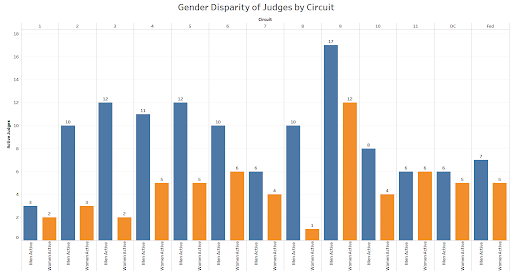The New Gender Dynamics Of The U.S. Courts Of Appeals
A data-driven look at the appellate bench after Trump.
 Ed note: We are pleased to welcome the writers of The Juris Lab, where this article first appeared, to our pages. Founded by quantitative legal analytics expert and Empirical SCOTUS creator Adam Feldman, The Juris Lab is a forum where “data analytics meets the law.”
Ed note: We are pleased to welcome the writers of The Juris Lab, where this article first appeared, to our pages. Founded by quantitative legal analytics expert and Empirical SCOTUS creator Adam Feldman, The Juris Lab is a forum where “data analytics meets the law.”In a speech that garnered much public attention entitled “A Latina Judge’s Voice” then-Judge Sonia Sotomayor spoke about the importance of individuals with diverse life experience on the federal bench. Two aspects of diversity Sotomayor raised related to race and gender. What is the importance of difference? Sotomayor explained, “Whether born from experience or inherent physiological or cultural differences … our gender and national origins may and will make a difference in our judging.”

Thomson Reuters' Claims Explorer: A Powerful Tool For Legal Claim Identification

Nearly 20 years after this speech, there still is much room to add dimensions of diversity to the federal bench (here is a link to a previous post looking at aspects of judges’ diversity by appointing president). Specifically, the federal bench continues to be dominated by men. The balance of men and women on the federal courts of appeals present a microcosm of this dilemma as no federal circuit has more women than men on the bench. The breakdown of judges by sex is presented below:

Some of the statistics are noteworthy are worth illuminating. First, the circuit with the most men is the 9th. The 9th Circuit also has more female judges than any circuit. The circuit with the greatest gender imbalance with a ten to one ratio is the 8th. Finally, the only evenly balanced circuit is the 11th.
Sponsored

Thomson Reuters' Claims Explorer: A Powerful Tool For Legal Claim Identification


Luxury, Lies, And A $10 Million Embezzlement

Law Firm Business Development Is More Than Relationship Building

Luxury, Lies, And A $10 Million Embezzlement
Trump’s confirmed nominees to the federal courts of appeals were heavily male dominated, as he did not appoint more women than men to any of the circuits during his four years as president.

Trump appointed only men to the 2nd, 3rd, and 8th Circuits. On the other side of the coin he appointed an even number of men and women to the 10th and 11th circuits. Trump’s impact on the face of the federal courts of appeals, however, was significant. The only circuits he did not appoint any judges to were the 1st and Federal Circuits. The following graph shows the percentage of active judge seats Trump filled on each circuit, moving from the most impacted circuits to the least.

Sponsored

Curbing Client And Talent Loss With Productivity Tech

Ranking The Law Firms Lawyers Love
These bars demonstrate that Trump filled over one-third of the seats on more than half of the federal circuits. Although he did little to overturn the gender imbalance on the federal courts of appeal, he changed the faces of federal judging for years to come.
Justice Sotomayor, toward the end of her speech, warned that, “There is always a danger embedded in relative morality, but since judging is a series of choices that we must make, that I am forced to make, I hope that I can make them by informing myself on the questions I must not avoid asking and continuously pondering.” This question of the sociodemographic dimensions of the future of the federal bench remains open-ended and is one piece of the puzzle that future presidents may or may not wish to resolve. With the first female vice president now about to hold office, expectations are high for this gender imbalance in the federal courts to be diminished from its current state.







